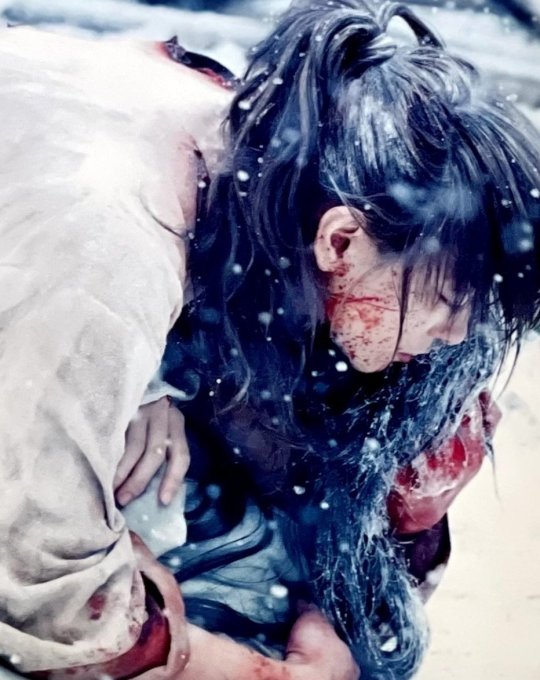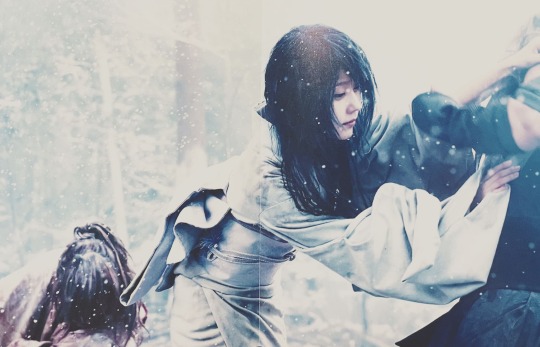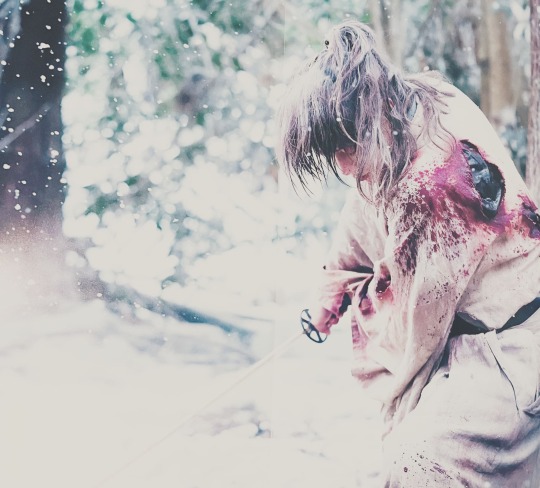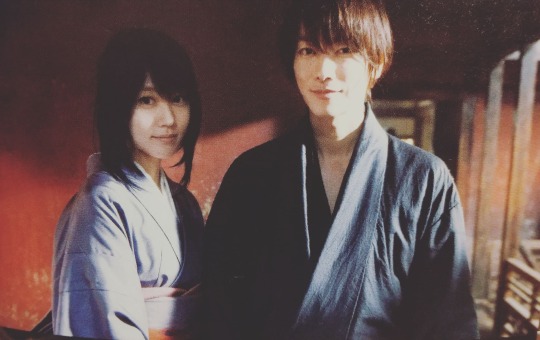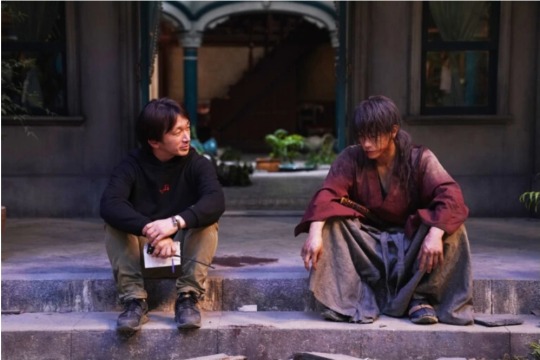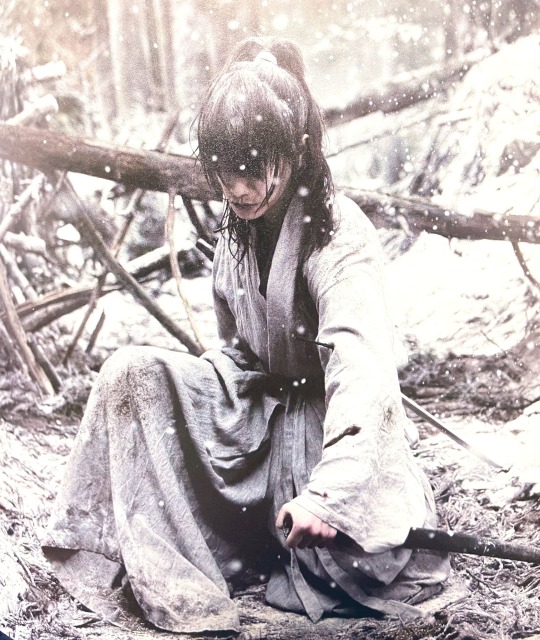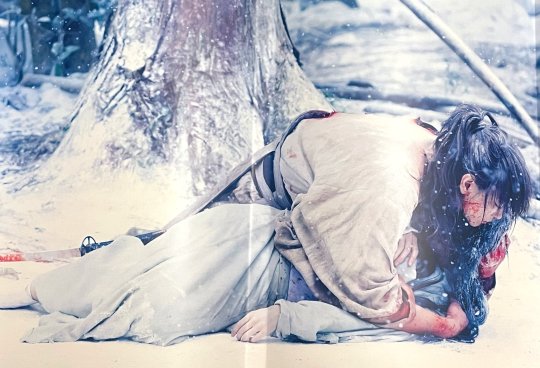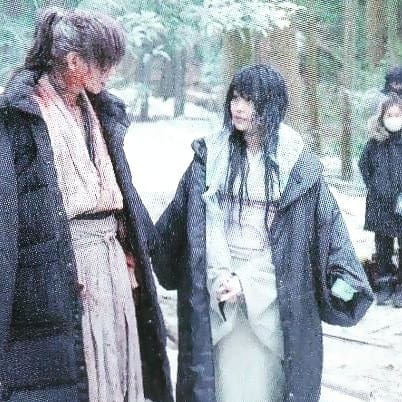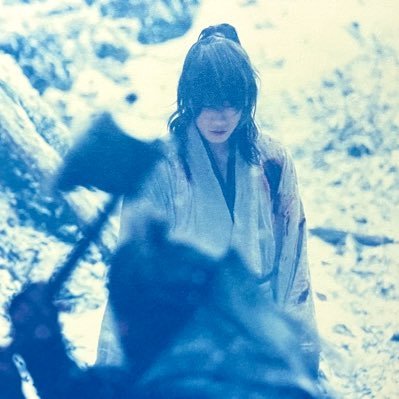Text

The Melancholic Dance of Time - A Rurouni Kenshin Fanfiction
Enter the shadows of Bakumatsu, where Battousai, an enigmatic Ishin Shishi, holds the dual mantle of god and demon. As a ruthless killer, he holds the key to Ishin Shishi's dominance. However, when he crosses paths with the mysterious Tomoe, the narrative takes a riveting turn.
FF | AO3
Author: ink-dusted-dreams/floatingrumi
The Bakumatsu era in Rurouni Kenshin has always captivated me. Perhaps it's my historical fascination with that period, or maybe it's the story's intricate plot. While the plot complexity deserves praise, the real credit goes to the compelling nature of history itself.
I've always lamented the limited Bakumatsu era chapters. However, I understand the constraints of the shonen genre, which likely necessitated significant filtering.
Furthermore, Kenshin's heroism is debatable. The Meiji Restoration's merits are still a subject of historical debate.
Initially, the Ishin Shishi's methods bordered on terrorism. This makes portraying Kenshin as a pure hero difficult, which is reflected in the fanfiction.
My goal is to rewrite the Remembrance Arc with greater historical nuance.
#kenshin x tomoe#rurouni kenshin#himura kenshin#himura tomoe#yukishiro tomoe#samurai x#るろうに剣心#kentomo#love#fanfiction#ao3 fanfic#ao3 writer#fanfics#ao3fic#enemy to lovers#historical#japanese history#bakumatsu
0 notes
Text
Mysteries of Tomoe's Grave
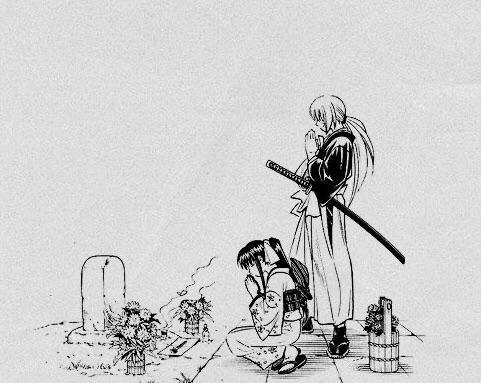
Kenshin and Tomoe's relationship is complex. The story remains a mystery and devoid of an objective narrator, only told from the perspective of Kenshin.
Readers of the manga and viewers of the anime are familiar with the grave Kenshin visits ten years after his fight with Shishio and when he finally settles at the Kamiya Dojo as his new home. However, this raises several questions.
Why Kyoto?
Some fans argue that Kenshin and Tomoe's relationship wouldn't have lasted had she lived, believing Kenshin would be overwhelmed with guilt. Yet, Tomoe's grave being in Kyoto is significant evidence to the contrary.
Tomoe didn't die in Kyoto; at the time of her death, she was in the countryside with Kenshin. Weeks after her death, Kenshin learns the truth from Tomoe's diary—that he was the killer of her fiancé. Before her death, she had already confessed to Kenshin that she was from Edo. If Kenshin felt guilty about loving her, it would seem logical to create her actual grave in Edo, not Kyoto. Moreover, if he buried her without much thought, burying her in the countryside, where she took her last breath, would make more sense.
Kyoto was significant as the place where Kenshin and Tomoe met and where Kenshin spent years after her death. Perhaps he wanted her to be close to him, thinking he might not survive the war. When he proposed to Tomoe, he expressed uncertainty about the future and a commitment "till death parts us," which surely stemmed from anticipation of his own death and not hers.
Shocked by her passing, he repeatedly questioned why it happened.
My personal theory is that the temple where Tomoe's grave is located might have been where they were married.
How did he obtain a grave, and who maintains it?
It may seem simple, but Kenshin came from a very poor family, and his involvement with the Ishin Shishi, combined with his lack of interest in wealth or glory, suggests his earnings were very limited. From the beginning of the series, we see Kenshin as poor and essentially jobless. Yet, a grave, especially one in a temple, was and still is very expensive. He must have spent everything he had to secure that grave.
Moreover, when he visits the grave 10 years later, it is still there and remarkably clean, implying he has continued, and perhaps still continues, to pay for the maintenance of the grave.
Will Kenshin eventually be laid to rest there as well?

Upon examining the image, it's noticeable that Tomoe's grave differs from the others, even though it occupies a similar space. This variation stems from the Japanese tradition where a grave is not solely for an individual but shared with family and, occasionally, friends. Given that "Himura" Tomoe is interred there, it strongly suggests that Kenshin will be buried alongside her after his passing. This prospect adds a poignant sense of closure to their narrative.
#rurouni kenshin#kenshin x tomoe#yukishiro tomoe#himura kenshin#himura tomoe#kentomo#るろうに剣心#loss#love#closure
22 notes
·
View notes
Photo
They have captured the essence of Kenshin and Tomoe in its entirety. Utterly beautiful.

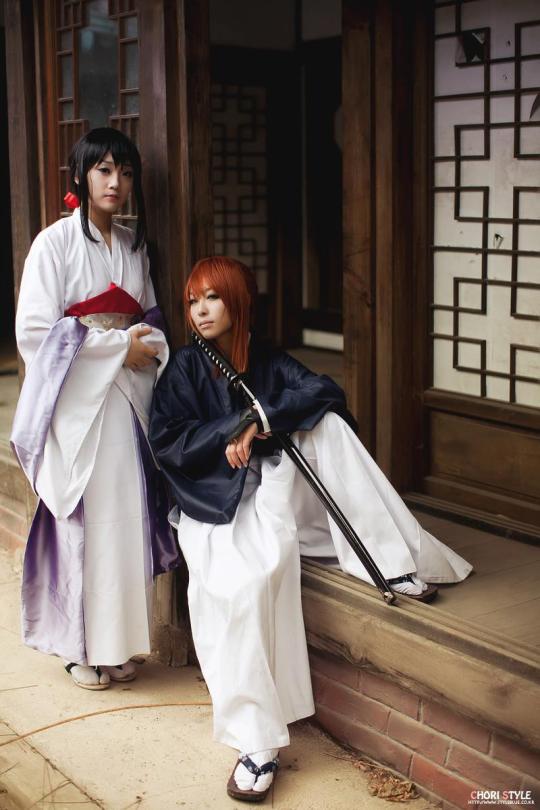

Tomoe Yukishiro - Rurouni Kenshin Tsuiokuhen
Year: 2011
136 notes
·
View notes
Text

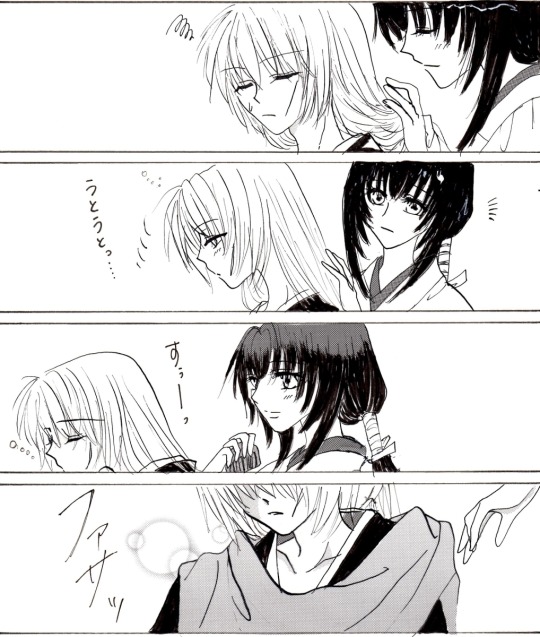

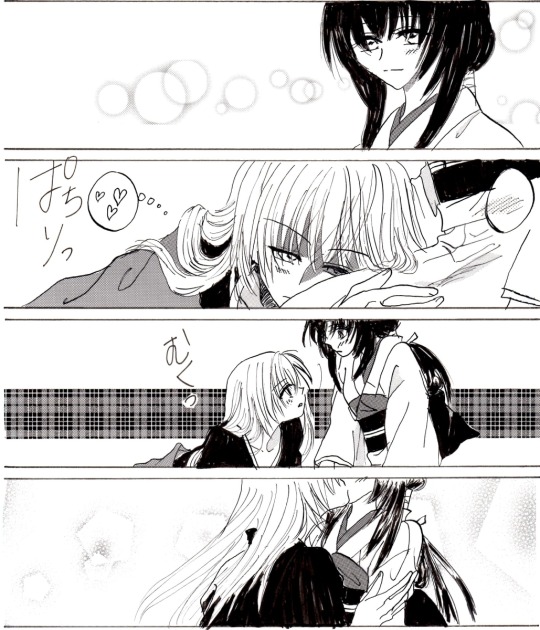
Art by 睦月ぬか. All credit goes to the wonderful artist.
No words can describe the depth of my affection for this pairing. Their chemistry is truly remarkable, whether within the pages of the manga, in the live-action, or in the OVA. The thought of revisiting the story is bittersweet, it is a reminder that we will never again witness Kenshin's raw vulnerability, unfiltered honesty, and unabashed openness with anyone else.
#kenshin x tomoe#rurouni kenshin#himura kenshin#himura tomoe#samurai x#yukishiro tomoe#るろうに剣心#kentomo#love#romance#couple in love
16 notes
·
View notes
Text
How Tomoe continued to surpass Kaoru in popularity until 2022, causing disappointment to the author

Throughout the history of Rurouni Kenshin, Tomoe has remained one of the most polarizing characters – either adored or vehemently disliked – but predominantly adored.
Now, let's delve into some context. Rurouni Kenshin features some female characters with less-than-stellar development. This isn't a critique exclusive to Rurouni Kenshin; it has been a prevailing trend in Shounen mangas overall. The female characters in Shounen manga often lack the realism associated with their male counterparts. To clarify this notion of "shortcoming," it's essential to note that the female characters in Rurouni Kenshin exhibit more complexity than those in many other Shounen mangas, particularly those from the 1990s. Watsuki acknowledges being influenced by Shoujo mangas, and this influence subtly reflects in his writing style.
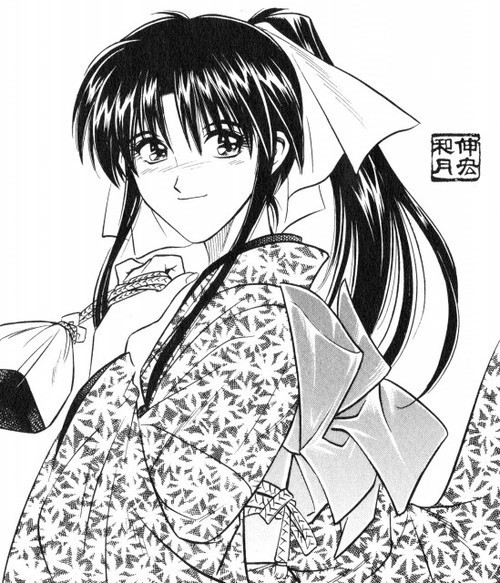
If one examines all the female characters in Rurouni Kenshin, a noticeable contrast emerges when comparing them to Tomoe. Take, for instance, Kaoru and Misao. Their personalities are characterized by cheerfulness, brightness, a certain lack of intellectual prowess beyond martial arts, and profound love. Despite being portrayed as strong, independent women of the Meiji era, their strength might be influenced by their familial wealth.

Initially, the author doesn't consider Kaoru as a romantic partner. However, as the plot unfolds, a romantic dimension is gradually introduced, starting with Kaoru and eventually becoming mutual. As the narrative progresses, the author subtly transforms it into "the" romance in Rurouni Kenshin.
Throughout the story, Kaoru remains anxiously concerned about Kenshin, fearing his departure until the conclusion of the Kyoto arc when he finally decides to call the Kamiya Dojo his home. By this point, readers are acquainted with Kaoru as a main character and Kenshin's primary love interest. There is widespread support for their relationship, with Kaoru emerging as the key to Kenshin's happy ending – a home and a peaceful life. However, at this juncture, neither the readers nor, to some extent, the author is privy to Kenshin's past – the events that shaped his philosophy, altered his speech, actions, and demeanor.

And then his past is gradually unveiled. Tomoe is initially presented to us as an illusion perceived by Kenshin, prompting him to call out to her. It becomes apparent that she holds significant importance, perhaps too much for Kenshin to risk losing himself, especially when he encounters her brother after a decade. Subsequently, we delve into the Jinchuu arc, a revelation that likely surprises every reader who had previously cheered on Kenshin and Kaoru.
Kenshin's memories, particularly his narrative with Tomoe spanning just 14 chapters, are revealed in fragments. Despite the brevity, it unfolds as a love story of epic proportions in classical literature. We witness Kenshin's life, his experience of love, his transformation, and the profound happiness he experiences, only to ultimately lose everything.
Watsuki, however, has openly expressed his dissatisfaction, acknowledging that he feels he has tarnished Tomoe's character. Originally envisioned as an "extremely beautiful woman" with a cold demeanor, Watsuki's initial concept was a "cool beauty" akin to Ayanami Rei but with black eyes. As the Remembrance Arc concludes, Tomoe evolves into a character that remains enigmatic, not fully understood by the author, the protagonist, or the readers, with only fragments to piece together.

Now, these 14 chapters form the cherished cornerstone of the entire franchise - Rurouni Kenshin: Trust & Betrayal, one of the most acclaimed masterpieces in the anime world. Kazuhiro Furuhashi and Masashi Sogo skillfully translate these chapters into a heartbreakingly beautiful narrative on screen.
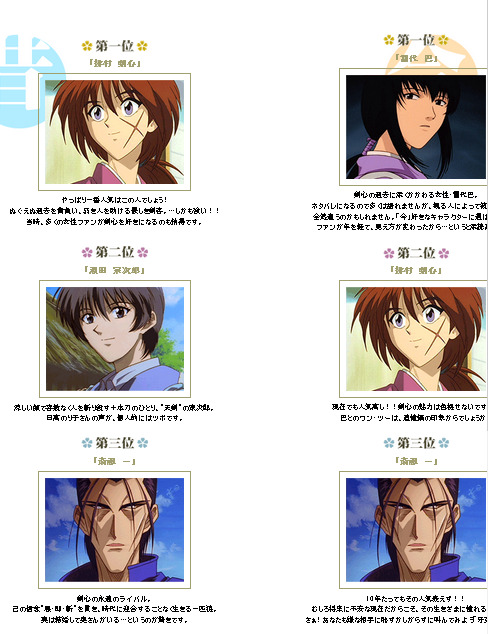
In the above image, the ranking on the left shows the past ranking and the ranking on the right shows the later ranking.
Source: Official Rurouni Kenshin website
Remarkably, Tomoe garnered immense love from Japanese fans, securing the top spot in the official popularity ranking—surpassing even Kenshin and Saito, a feat nearly unheard of. Much of this acclaim can be attributed to Ayanami Rei's character design and Tomoe's embodiment of the Yamato Nadeshiko demeanor. This adoration endured for a substantial period, possibly until 2022. Despite Watsuki's original intentions, Tomoe consistently stood out as one of the most beloved characters, notably surpassing the main female lead.

Source: Netflix (Search for "Rurouni Kenshin")
The enchantment of the Remembrance arc persisted, extending to the live-action adaptations. Rurouni Kenshin: The Beginning, despite having the lowest box office collection, emerged as the most beloved live-action film in the Rurouni Kenshin franchise on Netflix, securing a position in the top 10 films in 69 countries and maintaining its presence in the Global top 10 for a remarkable 8 weeks. In contrast, Rurouni Kenshin: The Final, achieved a lower performance, spending 3 weeks in the top 10 films and attaining top 10 status in 17 countries.
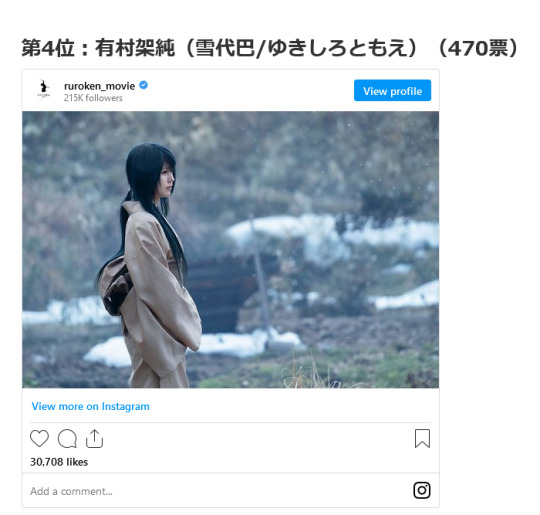
Source: Rankingu
In the live-action character popularity rankings, Arimura Kasumi's portrayal of Tomoe holds the impressive 4th position, reaffirming her status as the most beloved female character, once again outshining the female lead character.
#kenshin x tomoe#rurouni kenshin#himura kenshin#himura tomoe#yukishiro tomoe#るろうに剣心#kentomo#anime#anime and manga
14 notes
·
View notes
Text

Title: 幸せ
Source: Inkdusteddreams
Pixiv: https://www.pixiv.net/en/artworks/114296991
How I wish that these moments, like fleeting whispers of eternity, might linger a breath more in the dance of time.
#kenshin x tomoe#rurouni kenshin#samurai x#himura kenshin#himura tomoe#yukishiro tomoe#るろうに剣心#love#kentomo#fanart#ai art#anime art
22 notes
·
View notes
Text





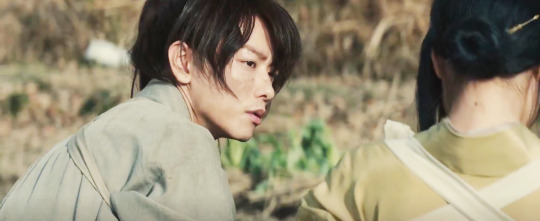

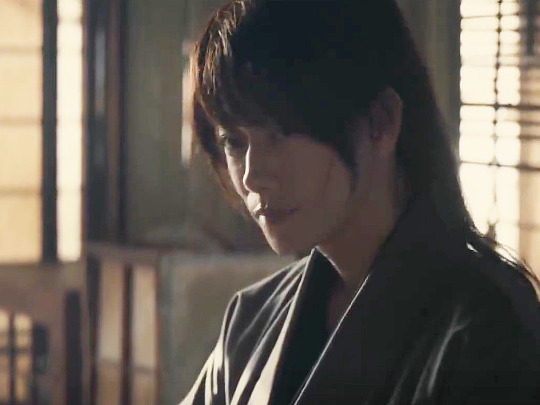

In our lives, we encounter numerous love stories, whether through media or reality. There are tales where you observe a character gazing at another, and you instantly grasp the depth of affection. I believe this is one such narrative. Whether it unfolds in The Beginning or Trust x Betrayal, you consistently witness Kenshin casting his gaze upon Tomoe, even when she isn't looking, and it's overwhelmingly tender. It's the kind of love that prompts the question, "Have you seen the way he looks at her?" I suppose.
Most importantly, this is Battousai. Kenshin, after his Battousai days, when he meets the Kenshin-gumi, looks at and observes everyone, perhaps to find their feelings. When he finds happiness, a part of him heals, and when he finds sadness, he tries to help.
However, Battousai is different; you will mostly find him not looking at anyone except her.
#kenshin x tomoe#rurouni kenshin#samurai x#himura kenshin#himura tomoe#yukishiro tomoe#るろうに剣心#love#kentomo#loss
10 notes
·
View notes
Text

Every time I see this scene, sadness grips me. This panel lays bare the deep intimacy shared by Kenshin and Tomoe.
If you scrutinize this panel, you will observe Kenshin and Tomoe have been sleeping on the same futon, cocooned under the same shared blanket, and most importantly, Kenshin is sleeping while facing her. Kenshin lies so deep in sleep that he remains oblivious to Tomoe's departure as she rises, dons her attire, and silently leaves.
This is the very man feared as a demon, even by his comrades. The very man who, once unable to sleep without clasping a sword and maintaining an upright posture.
The poignancy lies in the fact that, following this panel, all joy and tranquility will dissipate, vanishing alongside the person around whom his world revolves.
#kenshin x tomoe#rurouni kenshin#samurai x#himura kenshin#himura tomoe#yukishiro tomoe#るろうに剣心#love#kentomo#loss
34 notes
·
View notes
Text
The original Japanese manga of Rurouni Kenshin reveals a significant distinction in Kenshin and Tomoe's relationship, a detail overlooked in the English translation
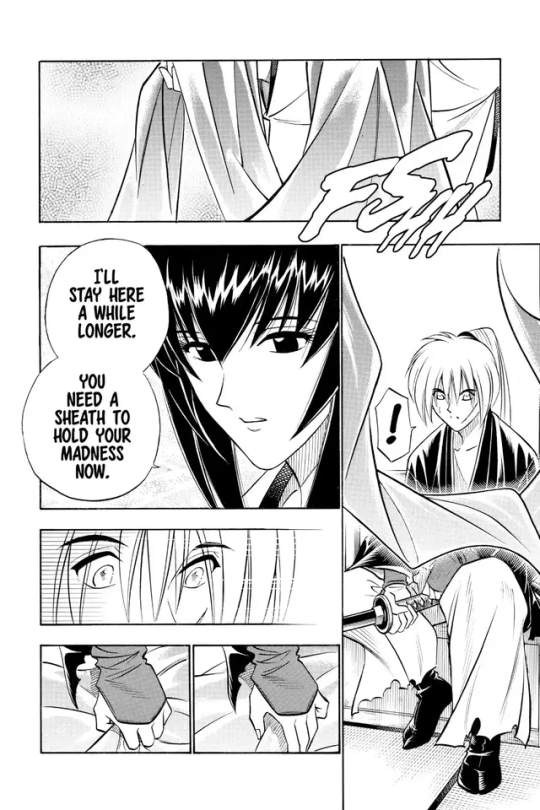
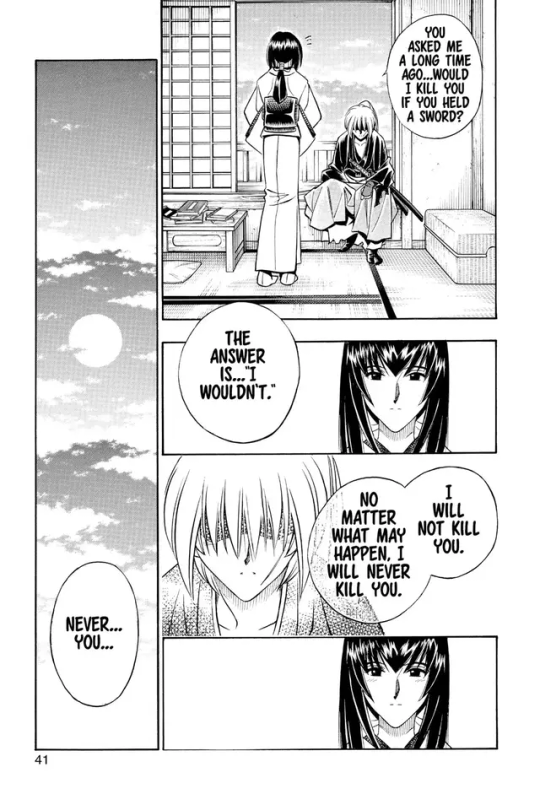
As mentioned in several of my previous posts, I believe that translating from Japanese to English often results in the loss of nuances specific to Japanese. The timeline of Kenshin falling in love with Tomoe is not as evident when reading the Manga in English, but it becomes quite apparent in Japanese. Therefore, in this post, I will explore some aspects lost in translation.
It's important to note that the challenge in understanding Kenshin and Tomoe's feelings arises from their reserved characters, contrasting with more expressive characters like Kaoru, Megumi, Sano, Yahiko, Misao, etc. Kenshin and Tomoe, being extremely reserved, disclose very little about themselves. Tomoe, in particular, is even more reserved than Kenshin, who, despite his reserved nature, is more expressive about his feelings, at least to Tomoe.
The scene I aim to decipher today is the one where Kenshin states that Tomoe is the only person he would never kill, even if she had a katana against him.
Towards the end of the scene, both characters blush. While it does seem special when Kenshin makes that statement, essentially expressing that she is special to him by being the only one he would never kill, the weight of this sentiment is significantly different when read in Japanese.
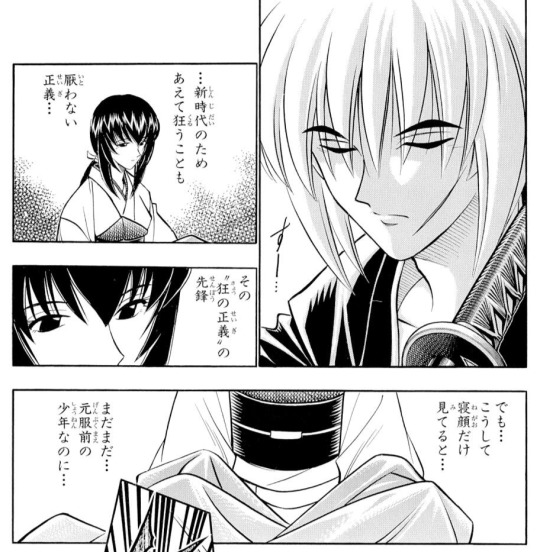
In the preceding scene, we catch one of the exceptionally rare glimpses into Tomoe's emotions. In her internal monologue, she reflects on Katsura's words regarding the beliefs of Ishin Shishi. Her monologue goes like this,
…新時代のためあえて狂うことも厭わない正義…
Translation: Justice where one dares to go mad for the sake of a new era
その狂の正義の先鋒
Translation: The vanguard of that justice of madness
でも…こうして寝顔だけ見てると…
Translation: But.. when I look at his sleeping face like this...
まだまだ…元服前の少年なのに…
Translation: He is still... just a young boy who has not had his Genpuku yet...
Tomoe's internal monologue reveals that, up to this moment, she perceives Kenshin not as a man but as a child.

In the aforementioned scene, he experiences a complete breakdown - unable to stand up, breathing heavily, and sweating profusely, yet he tells Tomoe to leave. He says,
市井の人は斬らないと大口叩いたところで今の俺はこの有り様…
Translation: Even though I talked big saying I don't kill ordinary citizens... look at me now...
もう出て行ってくれでないと俺はいずれ本当に君を…
Translation: Please leave already
If you don't, someday I'll really... you...
However, his panic is not stemming from the fact that he mistakenly drew his sword on someone. Instead, it arises from the deep feelings he harbors for her, a point made evident in the manga. The manga subtly conveys his emotions through the use of Yobisute (呼び捨て), a significant gesture. For those familiar with Japanese anime, it's known that addressing someone often involves adding suffixes such as -san, -kun, -chan, and so on.
Kenshin consistently employs honorifics when conversing with women. Even in his childhood, he referred to the girls he traveled with using -san. When initially speaking to Tomoe, he addressed her as "Tomoe-san" and utilized "Anata" as a pronoun, a clear indicator of respect. This choice becomes even more apparent as Tomoe is older than him. However, in this particular scene, he opts for "君" (kimi), a pronoun not paired with the -san suffix. He completely drops honorifics.
This is a significant development because many Japanese readers recognize Kaoru's importance to Kenshin when he omits the honorific and calls her "Kaoru" once. In romance mangas, the moment when characters drop honorifics is considered very special.
In the live-action adaptation, Kenshin continues to use "Anata" at this point, switching to "Kimi" only after they are married. In the manga, Kenshin's way of addressing her suggests a sense of possessiveness, even when she remains emotionally distant.
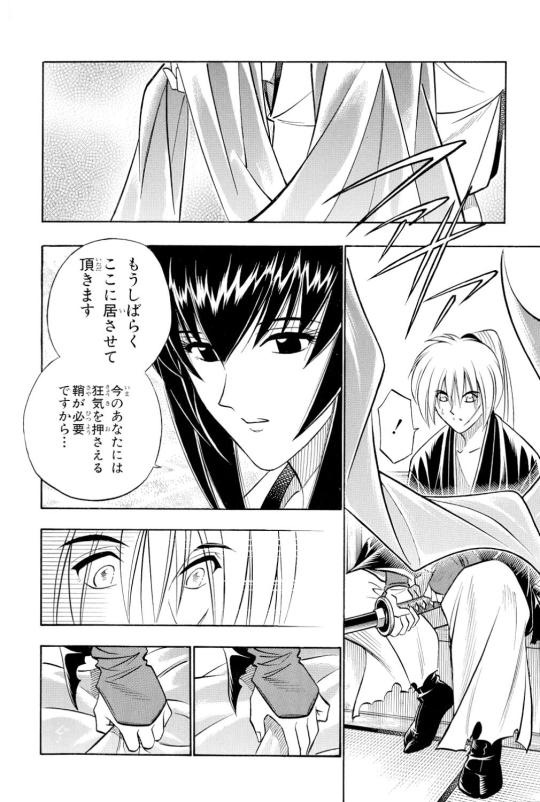
In the scene described above, Tomoe places her shawl on Kenshin, and his heavy breathing ceases. She tells him,
もうしばらくここに居させて頂きます
Translation: I'll be here for a while longer
今のあなたには狂気を押さえる鞘が必要ですから…
Translation: You need a sheath to suppress your madness right now...
If you observe, she isn't seeking his permission. She's simply stating that she will be with him for an indefinite period. She isn't explicitly expressing a desire; she's making a declaration. She can only do this with someone who, after telling her to go out, she knows didn't mean it and will allow her to be with him. So, I suppose she has a strong awareness of his feelings (which is quite evident, given the Yobisute).

In the above scene, he confesses that she holds a special place in his heart, expressing it verbally. Kenshin avoids direct eye contact, showing a slight blush. Tomoe also blushes slightly, marking the moment when she ceases to see him merely as a boy and begins to perceive him as a man. He says,
ずっと前の問いの答えー…
Translation: The answer to the question from a long time...
君が刀を手にしたら斬るか否か…
Translation: Whether I'd kill you or not if you picked up a Katana...
答えは「斬らない」
Translation: The answer is "Won't kill"
おれは斬らない
Translation: I won't kill
どんなコトがあろうと君だけは絶対に斬ったりしない…
Translation: No matter what happens, you are the only one, I'll never kill...
君だけは…
Translation: Only you...
絶対に…
Translation: Never...
When reading the English translations, the entire Yobisute is not discussed because both "Anata" and "Kimi" are translated as "You." However, in Japanese culture, this is a significant matter, indicating the distance between two individuals. The impact would not have been as profound if Tomoe were much younger than Kenshin. However, precisely because Tomoe is older than Kenshin, when he drops the honorifics, his feelings become completely evident.
#kenshin x tomoe#rurouni kenshin#samurai x#himura kenshin#himura tomoe#yukishiro tomoe#るろうに剣心#love#kentomo#battomo#anime#manga#romance
23 notes
·
View notes
Text
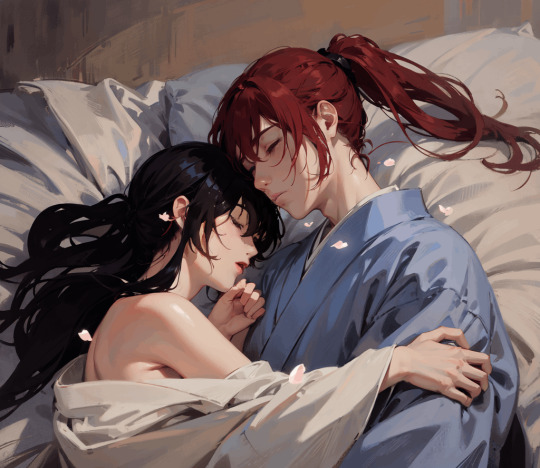
Title: そうして‥抱きかかえて寝る
Source: inkdusteddreams
Pixiv: https://www.pixiv.net/en/artworks/113091304
I find it challenging to express why their story captivates me so profoundly. It's an unusual connection between an assassin and a spy who seems detached from life, compelling me to uncover their fate.
Picture a young woman confronting a teenager, the very one who took the life of her fiancé. Yet, when she gazes at him, she sees not a ruthless murderer but an immature boy, despite the blood on his hands and her lack of affection for him.


Consider an idealistic teenager, entrenched in a world devoid of personal sentiments, making calculated decisions for a revolution. Then, he encounters a woman, experiencing an immediate and deep attraction that evolves into profound love. Her mere presence brings him solace, even amidst the most tumultuous times.

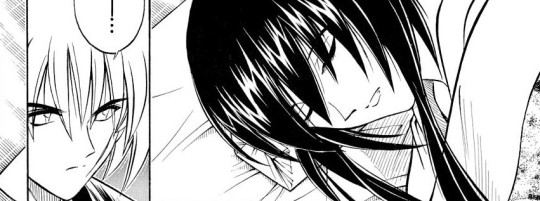
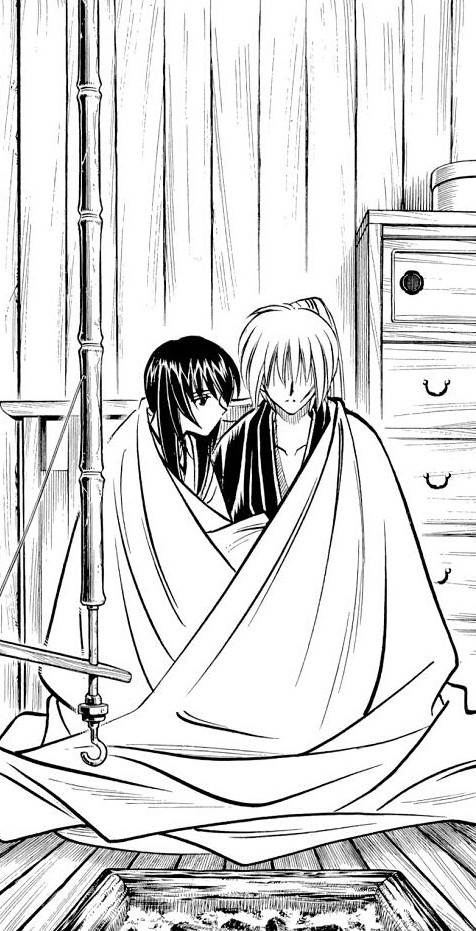
Perhaps it resonates because these two teenagers, worlds apart, find a connection through blood, deceit, and revolution. Despite societal forces working against them, they are willing to go to great lengths to protect each other.
Maybe it's the enduring impact that, even 15 years later, with his newly reconstructed life shattered, merely conversing with her spirit brings an immediate smile to his face.
A story of a cold, calculated, and idealistic young warrior navigating through a spectrum of emotions akin to any young man deeply in love.
While many readers emphasize the tragedy, I perceive it differently. Their story is laden with tragedy because it is infused with an abundance of love.
#kenshin x tomoe#rurouni kenshin#samurai x#himura kenshin#himura tomoe#yukishiro tomoe#るろうに剣心#love#kentomo#loss#art#fanart#ai art
92 notes
·
View notes
Text

Title: 剣心と巴 〜彼女の痛みをすべて取り除きたい〜
Source: inkdusteddreams
Pixiv: https://www.pixiv.net/en/artworks/112277040
Wrote from Battousai's POV:
In the quiet of her silence, I find myself pondering what mysteries she guards so closely. I can't help but wonder if, whether, she might one day share them with me. There's a distant gaze in her eyes, fixated on something beyond my reach.
Yet, I hesitate to ask. There's a delicate balance, a fear that if I pry too much, she might slip away like a fleeting dream. And so, I tell myself it's okay. She doesn't owe me the truth. In fact, I'd rather have her near, wrapped in the enigma she carries.
But, if only I could grasp the weight of her pain. I'd willingly drink it away, leaving nothing but the echoes of our shared existence.
As she lies nestled in my embrace, I wonder if she is thinking of me.
---
I can't count how many times I've read the Remembrance arc. At some point, it dawned on me that, right from the start, Kenshin, and probably Katsura-san, were acutely aware of the significant likelihood that Tomoe wasn't aligned with them. When Enishi paid a visit to their house in Otsu, Kenshin harbored suspicions about Tomoe as well. I comprehend that Kenshin loved and wanted to be with Tomoe, fully aware that she wasn't on their side and didn't subscribe to Kenshin's principles.
#kenshin x tomoe#rurouni kenshin#samurai x#himura kenshin#himura tomoe#yukishiro tomoe#るろうに剣心#love#kentomo#battomo
35 notes
·
View notes
Text
Analyzing the manga panels where Kenshin dreams of Tomoe after leaving Rakuninmura
These five pages hold a profound place in my heart, a beautiful testimony of the depths of love found in literature. To discover such emotional depth in a Shounen manga was beyond my expectations.
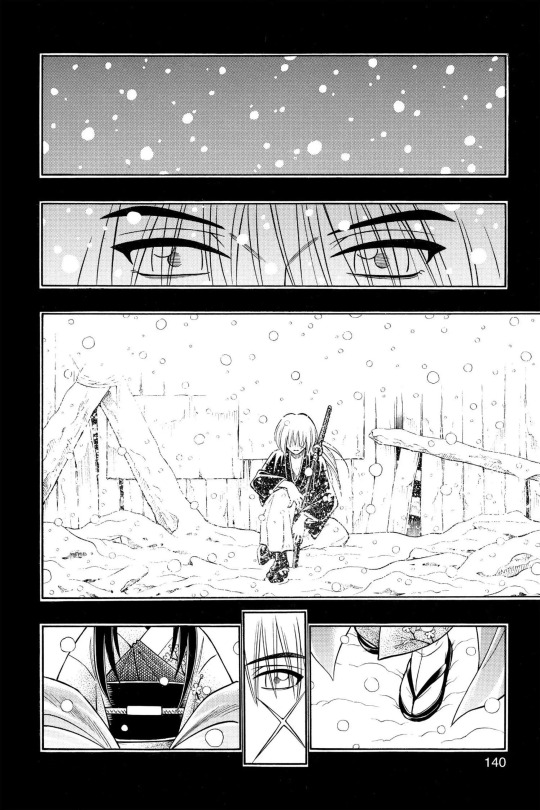

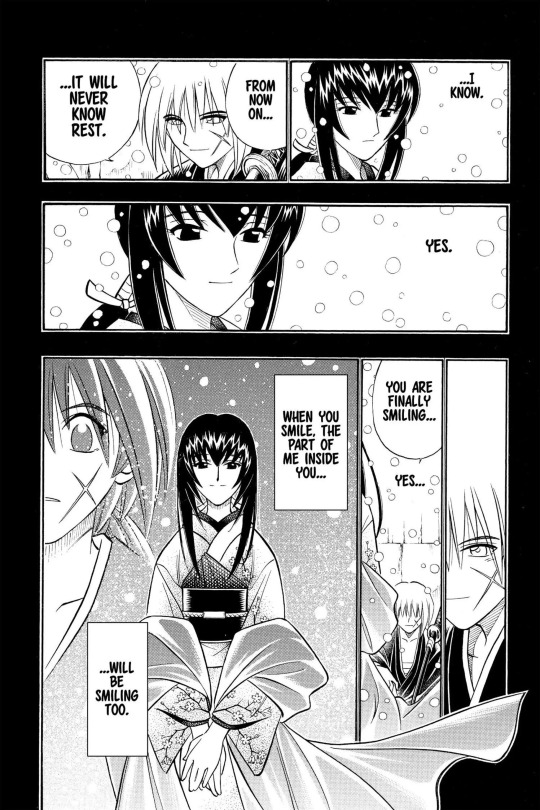
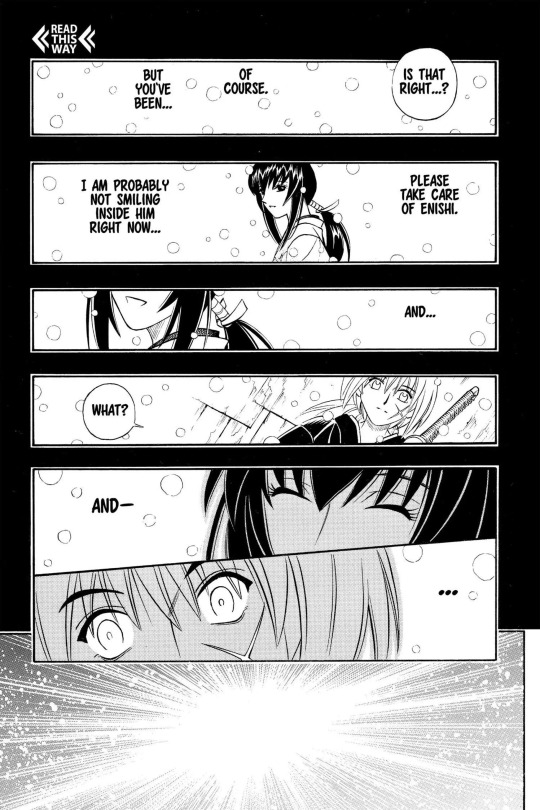

The scene unfolds with Kenshin gazing upon a familiar scenery. Yet, his eyes remain devoid of emotion, perhaps because this scenery has replayed within his mind countless times. In this moment, he believes Kaoru to be dead, he failed to protect her, her death is the grim result of revenge stemming from an accidental act - the death of Tomoe. He is uncertain if this vengeance aligns with Tomoe's wishes, for time has separated them for 15 years already. The home and love he found after 15 years of grieving for his late wife lie in ruins. His mind and soul are destroyed, and his eyelids weigh heavily, yet he gazes at the familiar scene before him.
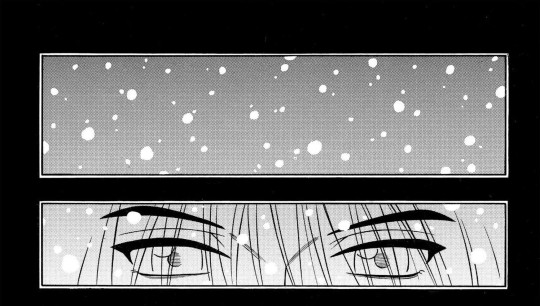
He knows what to expect as he recognizes the sound of familiar footsteps and the hem of the familiar kimono.

He soon gazes upon that familiar face, fully aware it's but an illusion, for she cannot exist in reality. Still, he continues to look at her. He refrains from speaking to her, perhaps believing she won't reply, a notion he's perhaps tested in the past.

It's truly heart-wrenching. Imagine someone incredibly dear to you, now long gone. You see an illusion, a ghost of that person, and you understand that no matter how much you call out, they'll never return. What will you do?
But this time, she speaks, and his eyes light up. He smiles, responds, and simply gazes at her as if that's all he ever needed.

I used to be genuinely puzzled by this. Many readers interpret Kenshin's emotions toward Tomoe as guilt, and I admit, I once shared that view. However, this chapter altered my perspective.
Yet, the right words to describe Kenshin's expression in these panels always eluded me. I eventually realized it might be because I had the entire backstory in my head. I had a hunch that an unrelated third party, someone unfamiliar with the story, might grasp it better. So, I shared these two panels with my artist mother, a 65-year-old who's never read manga or watched anime. Her observations were fascinating and truly eye-opening.

Regarding the panel above, I posed these questions to her:
"What emotions do you believe these two characters are experiencing?"
In response, my mother conveyed her thoughts on Tomoe, stating, "She appears to be showing concern."
As for Kenshin, her perspective was "A mix of surprise and sadness."
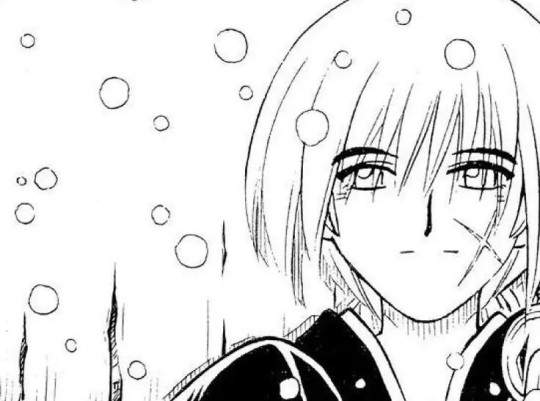
I went a step further and shared the image above with her because I've always found it challenging to discern his emotions. I believed that my mother, who is not only an artist but also a deeply empathetic individual, might be able to grasp his feelings.
Her response, after translation, was as follows:
"He appears to be gazing at something, and whatever he sees, he feels..."
She paused for a moment.
I asked her, "Do you think he feels happy?"
She replied, "No. I don't believe it's happiness; there's no sense of excitement."
She continued, struggling to find the right word, "It's more like...whatever he's witnessing... it's what he yearned to see. Like, this is it."
Finally, she found the word. Being of Indian descent, she used the term "Prashanti (प्रशांति)."
In my mind, everything fell into place. It was the word I had been searching for. "Prashanti" translates to "peace," but "peace" translates to "Shanti (शांति)." Prashanti, however, signifies "supreme peace." His expression seems to convey a sense of completeness.
In the next panels, he begins to talk about his conviction but averts her gaze. I found myself curious about this, but after reading the Japanese scanlations, it all became clear. Regrettably, I don't have all the pages to share here.
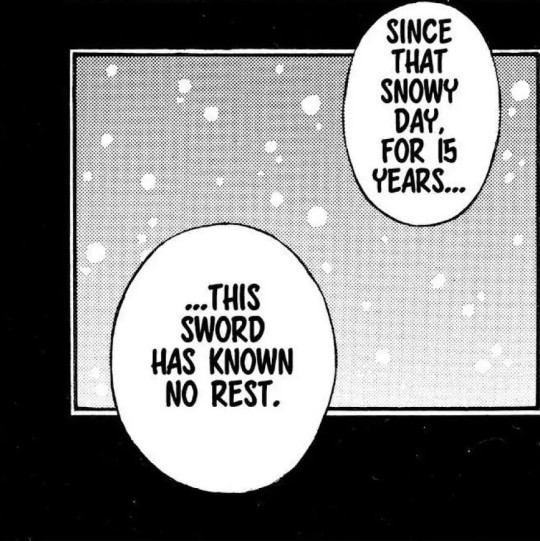
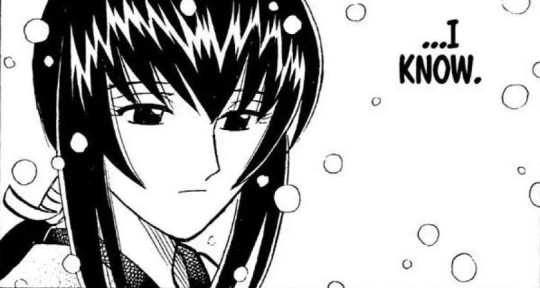
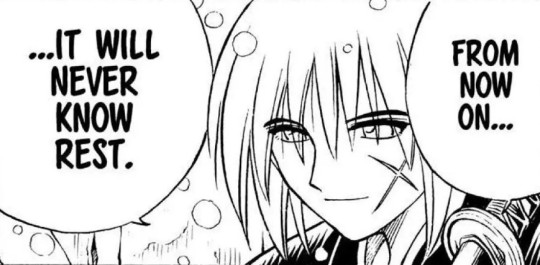
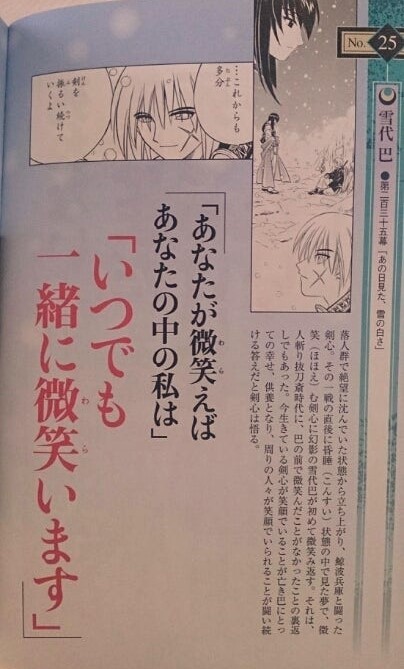
Instead of using "これからも" (which means "From now on"), he opts for "これからも…多分…" (which means "From now on... probably..."). He concludes all his sentences with "するよ" rather than just "する." This may seem subtle, but it carries significant weight because he's indirectly seeking her agreement. It's akin to the distinction between saying, "I will do it," and "You know, I will do it." Although both convey the same action, the latter grants the listener a greater say in the decision. In the context of Japanese, this difference is even more pronounced. It leads me to believe that, at this point, his promise isn't entirely set in stone.
In the next panel, Tomoe wears a serene smile and calmly responds, "Yes," as if she was aware of it from the start.

In the next panel, The translation reads "You are finally smiling." However, in the Japanese scanlations, it becomes apparent that he says "やっと笑ってくれた," which means "You are finally smiling for me."
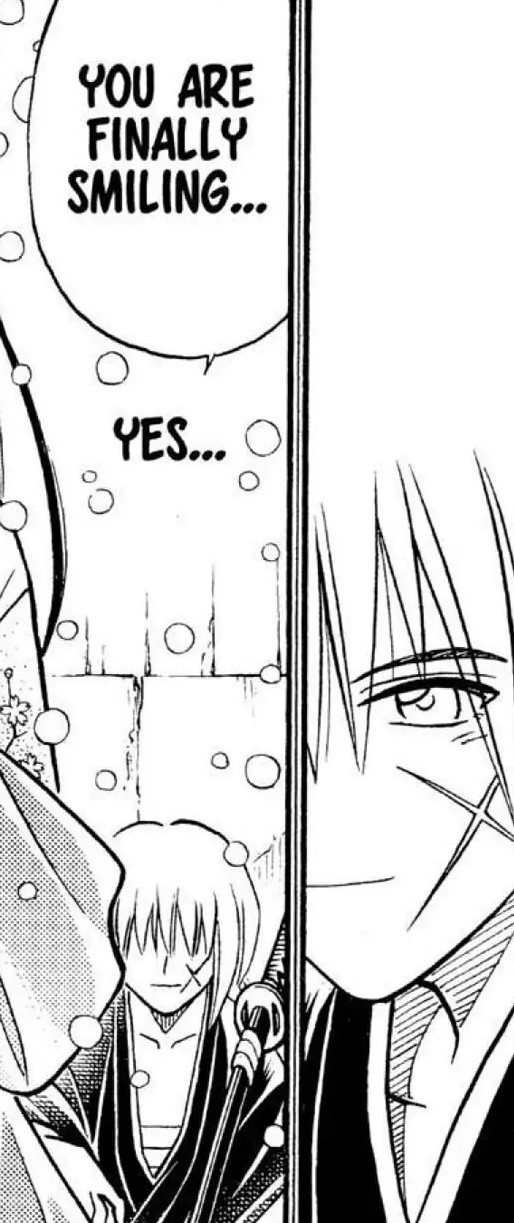
In the next panel, Tomoe tells him, "If you smile, the me inside you will always smile with you." We witness Kenshin's expression, a look of utter astonishment as if he had never fathomed such a notion, not even in his wildest dreams.

But this single panel reveals a world of emotion. It shows that Kenshin had never dared to imagine that Tomoe could feel that way for him. It also suggests that when Kenshin smiles during their conversation, it might just be the first genuine smile he's worn in 15 years because Tomoe mentions she smiles when Kenshin smiles, yet until then, she had never worn that smile.
To me, this reveals a lot about Tomoe's character. She doesn't possess the same kind of strength that Misao and Kaoru do, the strength to relentlessly pursue their love and hold onto it.
Yet, Tomoe imparts a profound lesson that we should all learn — the art of letting go.
She didn't prevent Kiyosato from leaving for Mimawarigumi. She didn't stop Kenshin from taking lives during his time as Ishin Shishi, despite it contradicting her own beliefs. Instead, she questioned him and let him make his own choices. As she approached her final moments, with her remaining strength, she wiped Kenshin's tears and consoled him, assuring him that everything was as it should be.
Nevertheless, she possessed the strength to be a mother figure and a caring sister to her brother, she had the courage to calmly stand in the presence of a killer, to watch, and to condemn the crime rather than the criminal.
Ultimately, she encouraged him to rise and go to the one who yearns most to see his smile — Kaoru.
It's beautiful because these pages reveal that to Kenshin, Tomoe's smile meant the world. Being with her was all he ever wanted; he never wanted to be apart from her. His love for her was very deep. That's why, hearing her voice, talking to her, and seeing her smile, even though none of it was real, brought him peace, even in the darkest moments, because it was what he truly desired.
Yet, whether we call it fate or a profound backstory to add depth to his character, it's what he lost.
#kenshin x tomoe#rurouni kenshin#samurai x#himura kenshin#himura tomoe#yukishiro tomoe#るろうに剣心#love#lovers#loss#character analysis
26 notes
·
View notes
Text
Battousai's scarf in the Rurouni Kenshin: Restoration Manga
Among the very few things that Rurouni Kenshin: Restoration has executed effectively, I find the inclusion of Tomoe's scarf in the flashback to be remarkably potent. I also appreciate the intricacies and the non-verbal cues.


He had the scarf wrapped around his mouth and nose as he stepped upon the puddles of blood. Knowing that it was the same scarf Tomoe carried with her, it probably still retained her scent. I kept pondering about what it might signify to him.
One day, I noticed that my aunt was regularly using her mother's (my grandmother's) shawl, though it was old and out of style. I wondered why she still used it, and she said, "It carries her touch, so I feel her presence with me."
I realize that, to Kenshin, who is enduring immense pain from losing his love, the scarf (it's actually a shawl he uses as a scarf) was likely the sole source of solace and reassurance remaining, a lifeline preserving his sanity amid the chaos, the anchor preventing him from falling apart.
#kenshin x tomoe#rurouni kenshin#samurai x#himura kenshin#himura tomoe#yukishiro tomoe#るろうに剣心#love#loss#grief
16 notes
·
View notes
Text
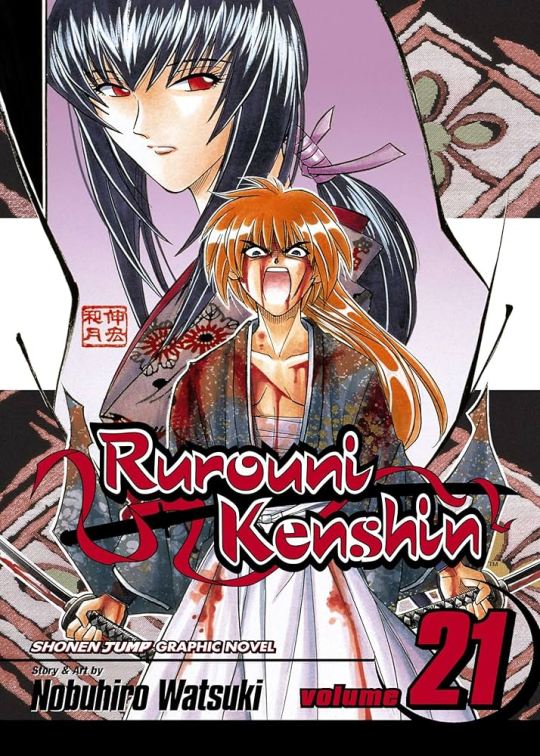
The cover of Volume 21 is powerful and heart-wrenching. When you realize how deeply Kenshin loved Tomoe and that she's no longer with him, no amount of wailing, screaming, grief, atonement, or self-loathing can bring her back - it's truly despairing.
We've all experienced the loss of loved ones; it's impossible to move on. We just come to accept that they do not exist in the physical realm, and as long as we live, time continues its relentless flow. We adapt to life without them while bringing them along with us in our souls.
Helen Keller beautifully expressed this sentiment:
For all that we love deeply, becomes a part of us.
10 notes
·
View notes
